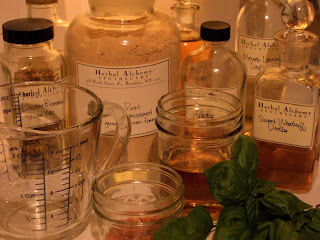 I spent a day poking around at estate sales in Long Island with a good friend a few weeks ago and had the good fortune to raid someone's liquor cabinet before anyone else got to it. I bought four bottles of booze, two whiskeys - one a blended Scotch called Black and White and another nearly empty bottle of moonshine labeled "pot still whiskey". The third was chosen only for the bottle and label. I doubt I will ever open that ancient bottle of Freezomint but I'll enjoy it's artificially colored glow on my liquor shelf.
I spent a day poking around at estate sales in Long Island with a good friend a few weeks ago and had the good fortune to raid someone's liquor cabinet before anyone else got to it. I bought four bottles of booze, two whiskeys - one a blended Scotch called Black and White and another nearly empty bottle of moonshine labeled "pot still whiskey". The third was chosen only for the bottle and label. I doubt I will ever open that ancient bottle of Freezomint but I'll enjoy it's artificially colored glow on my liquor shelf.The true find was a 3/4 full bottle of Chartreuse. I've been doing a lot of research the past few years on herbal liqueurs and amaros and have read abbreviated versions of many of the old recipes. Of all of the old formulas Chartreuse is the only one still made by Carthusian monks. They have been making it continuously since 1605. Other liqueurs have claimed to be made by monks but in reality are made by large companies. Benedictine, for instance, is an invention of Alexandre Le Grand who made up the story of the liqueur being a medicinal recipe of the Benedictine Monks in Normandy.
Chartruese is a secret recipe of more than 130 herbs and "secret ingredients". The formula is based on a recipe for an elixir of long life from an alchemical manuscript given to the monks. The monks intended their liqueur to be used as medicine but the beverage became so popular that in 1764 the recipe was adapted to what is now Green Chartreuse. In 1838 they developed Yellow Chartreuse, a sweeter version colored with saffron. Only two monks have the recipe at any one time and they are the only ones who prepare the herbal mixture.
 I took the vintage bottle to my local watering hole, the magical Barbes in Park Slope, one Saturday afternoon and presented it to the bartender who expertly removed the rotting cork without getting any in the bottle. We poured a glass of the vintage and a fresh glass from the bar. To my amazement there was a woman sitting at the bar who had just written a paper on Chartreuse for her French class. I sat with her comparing the two liqueurs and taking notes on anything that jumped out at me. Each sip revealed something new. One sip would coat my mouth in angelica, the next in mace, then mint, then vanilla as I swallow. I know that Chartreuse is sweetened with honey which is much more apparent in the vintage bottle.
I took the vintage bottle to my local watering hole, the magical Barbes in Park Slope, one Saturday afternoon and presented it to the bartender who expertly removed the rotting cork without getting any in the bottle. We poured a glass of the vintage and a fresh glass from the bar. To my amazement there was a woman sitting at the bar who had just written a paper on Chartreuse for her French class. I sat with her comparing the two liqueurs and taking notes on anything that jumped out at me. Each sip revealed something new. One sip would coat my mouth in angelica, the next in mace, then mint, then vanilla as I swallow. I know that Chartreuse is sweetened with honey which is much more apparent in the vintage bottle.I've been macerating herbs for the past couple of months to make herbal liqueurs. One of them, a creation of my own which reflects the herb garden at 6/15 Green Community Garden, has a strong similarity to Chartreuse. Angelica is the predominant note in chartreuse and the garden happens to have a healthy specimen. I used the fresh green leaf and stalk, dried root that I dug up last fall and the seed I had collected. I used nearly every other herb growing in the herb patch including chamomile, lemon balm, hyssop, mint, rosemary, basil and sage and fresh spices from the Park Slope Food Coop like cloves, mace and saffron as well as some dried herbs from my collection. This is my second year in a row creating a liqueur from the garden and I'm hoping this year's will be better for the few tweaks I made in the recipe. It's strained now and aging while I ponder which honey to use. I'm hoping to get some local Brooklyn honey at the farmer's market to keep it as local as possible. I'll be serving my elixir come holiday time.






